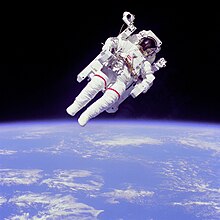Recent events
Astronaut Bruce McCandless II outside of the space shuttle Challenger in 1984
Main article: Modern history
See also: Modernity and Future
Change has continued at a rapid pace from the mid-1940s to today. Technological developments include nuclear weapons, computers, genetic engineering, and nanotechnology. Economic globalization, spurred by advances in communication and transportation technology, has influenced everyday life in many parts of the world. Cultural and institutional forms such as democracy, capitalism, and environmentalism have increased influence. Major concerns and problems such as disease, war, poverty, violent radicalism, and recently, human-caused climate change have risen as the world population increases.
In 1957, the Soviet Union launched the first artificial satellite into orbit and, soon afterward, Yuri Gagarin became the first human in space. Neil Armstrong, an American, was the first to set foot on another astronomical object, the Moon. Unmanned probes have been sent to all the known planets in the solar system, with some (such as Voyager) having left the solar system. Five space agencies, representing over fifteen countries,have worked together to build the International Space Station. Aboard it, there has been a continuous human presence in space since 2000. The World Wide Web became a part of everyday life in the 1990s, and since then has become an indispensable source of information in the developed world.




Comments
Post a Comment